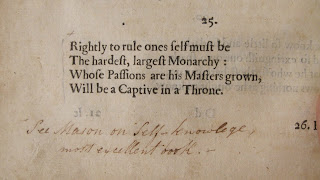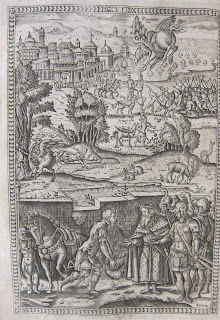Maximus of Tyre, Dissertationes [Paris] : Ex officina Henrici Stephani Parisiensis typographi, MDLVII [1557].
2 v. in 1 ; 19 cm. (8vo)
Renaissance Center copy is in later half calf and marbled boards; signatures of T. Lynford and Christopher Harvey "et amicorum" on title page; the price at the top of the page may be in Lynford’s hand; another ownership inscription in ink on the front pastedown has been almost totally erased
This Estienne edition of the Dissertationes of Maximus of Tyre contains a couple notable inscriptions on its title-page. The "T. Lynford" who signed the right side of page may be the Anglican clergyman (bap. 1650, d. 1724) who wrote a series of polemical religious treatises in the 1680s. As the catalog record (written by John Lancaster) for this book points out, the manuscript price at the top of the page may also be in Lynford's hand. The price reads "Pretium 3s."
The other inscription (sitting directly above the imprint) was carefully penned in a fine Italic hand, and reads "Christopheri Harvey & amicorum." The designation "& amicorum" ("and friends") is not as uncommon as one might think, and became famous as the French book collector Jean Grolier's (1479-1565) hallmark inscription. Christopher Harvey may be Anglican clergyman and poet (1597-1663) who wrote the series of devotional poems known as The Synagogue (1640). According to an essay and catalog published in 1906 (Rev. W.G. Clark-Maxwell, Transactions of the Shropshire Archaeological and Natural History Society), many books in the library at More Church, Shropshire also bear the manuscript inscription "Chr. harvey et amicorum."
Marco Girolamo Vida, Opera. Lyon: Apud Antonium Gryphium, 1566.
575, [1] p. ; 13 cm
Renaissance Center copy is in contemporary calf, with a single large panel stamp on each cover and author’s name in ms. on fore-edge (rebacked; covers detached); in phase box; signature of Richard Harvey on title page; armorial crest bookplate of George Thomas Wyndham (with motto "Au bon droit") on front pastedown; signature "Geo M[aplizdry?] his booke" on rear free endpaper; pencil note and clipped bookseller’s description laid in.
A sixteenth-century English "Harvey" also owned this pocket-sized collection of Vida's works, printed in Lyon by the famed Gryphius Press. The Italic inscription "r. harueij" ("R. Harvey's") belongs to Richard Harvey (1560-1630), the astrologer and younger brother of Gabriel Harvey (1552/3-1631), scholar and friend of Spenser. Harvey inscribed the author's name on the book's fore-edge:
It reads "uid:" i.e. "vid[a]." An early owner (perhaps Harvey) added this note to a detached leaf
It reads:
Huius Auctoris Constitutiones Synodales excusa sunt Cremona A.D. 1562. vide Auctarium Verderii ad Bibliothecam Simleri p. 24
or
The Synodical Decrees of this author were printed [at] Cremona in A.D. 1562. See Auctarium Verderii ad Bibliothecam Simleri [Verderi's addition to Simler's Library] p. 24
Vincenzo Conti printed the quarto Latin book Hieronymi Vidae Albae episc. et comitis Constitutiones synodales eidem ciuitati ac dioecesi praescriptae at Cremona in 1562. A quick search shows three copies in Italy, and one in the United States (Harvard). I have been unable to identify the cited title from the note (lost book?).
A pair of leaves laid in (one probably attached to the book at some time) record bookseller's research into the book, and provide evidence for its sale in the late nineteenth or early twentieth century.
Finally, the book's front pastedown bears the armorial crest bookplate of George Thomas Wyndham (1806-1830) of Cromer Hall, Norfolk.
Look for an update early next week with more images of manuscript material from this book that I haven't had a chance to photograph.
UPDATE: You will find two new images beIow just added today, both pieces of manuscript content from Vida, Opera.
John Lancaster (in his catalog notes) reads this inscription "Geo M[aplizdry?]," and I haven't come up with a better transcription. Anyone heard of this guy?
Finally there is this marginal note in Richard Harvey's hand on p. 193 (mentioned in the bookseller's description shown above). It reads "Homobonus Nouembris. 13," and accompanies some interesting pen marks and underlining. He refers to St. Homobonus of Cremona, whose feast day is November 13. I haven't figured out the Cremona connection between this marginal note and the note earlier in the book about the printing of Vida's Constitutiones synodales.













































